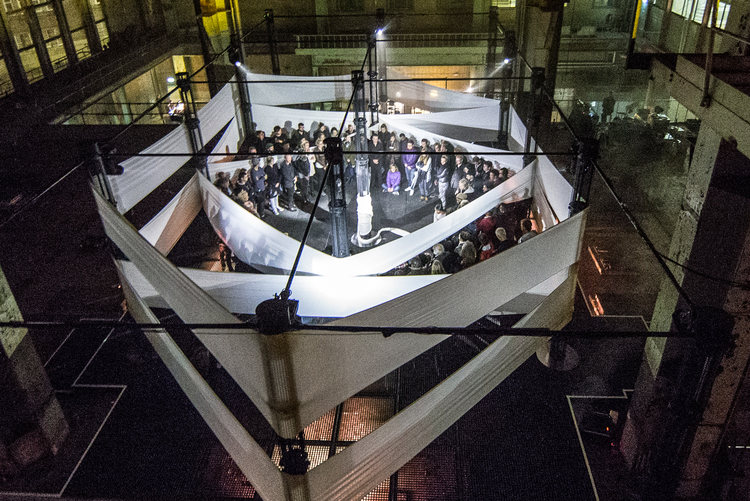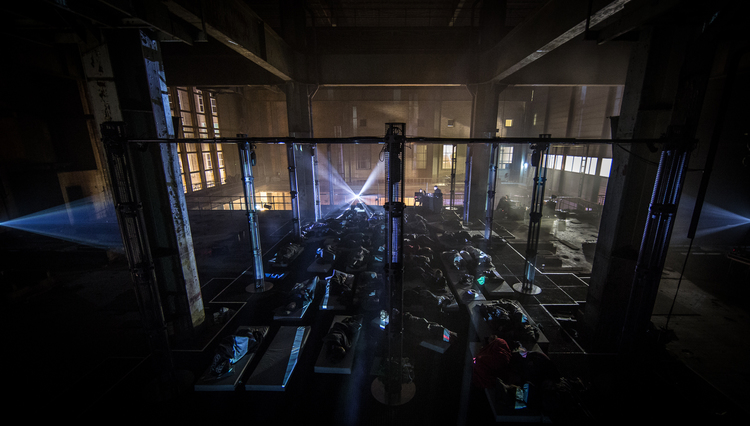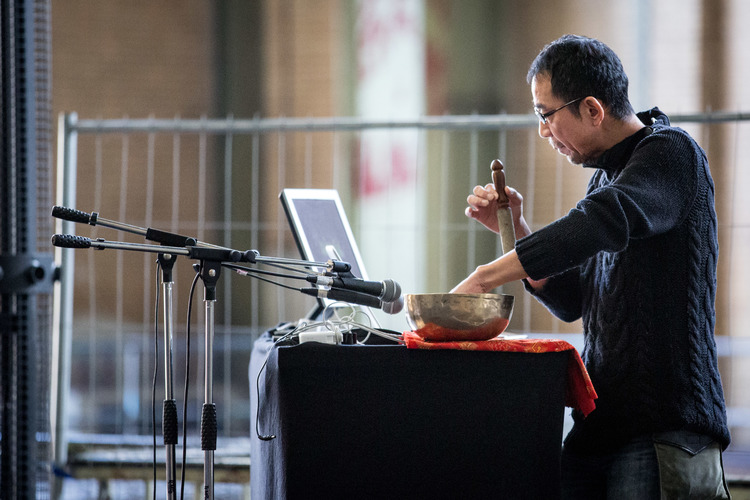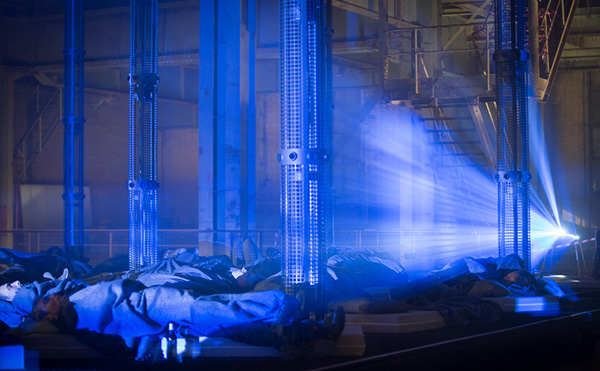Circadian: A Review (2016)
John Connell
4DSOUND’s creative director John Connell reviews the 24-hour curatorial programme ‘Circadian’, presented at TodaysArt Festival 2015, The Hague. Referencing the chrono-biological rhythms that govern the body’s biological processes over a twenty-four hour period, Circadian seeks to embody the actual state of the listener throughout peaks of mental clarity and physical alertness, and times of introspection and abstract associative thought.

Circadian featured a diverse range of inter-disciplinary artists. New York-based Lisa Park, a performance artist working with commercial EEG headsets to explore the influence of the environment on her emotional state, launched the festival with an interactive performance entitled NUE. In NUE, meaning silkworm in Korean, Lisa wrapped a 150 meter-long dress around the columns of the 4DSOUND system, encircling the audience in a series of walls and layers that unfolded as she performed, transforming the physical space. Driven by her emotional state- tracked and monitored as brainwaves through her EEG headset - a soundscape encompassed the audience, flickering and melting based on her focus, her tension or level of relaxation as she shed the layers of the dress, slowly freeing herself of a metaphorical past.
Circadian, premiered in September at TodaysArt, The Hague, is a direct investigation into this relationship between the sounding space and our ability to listen. Referencing the chrono-biological rhythms that govern the body’s biological processes over a twenty-four hour period, Circadian seeks to embody the actual state of the listener throughout peaks of mental clarity and physical alertness, and times of introspection and abstract associative thought.
We invited participants to spend an entire day and night with 4DSOUND to experience a series of meditative interactions, performances and sonic immersions. Circadian encourages the audience to tune into their response to the sounding artworks, and become more attentive to the influence this had on their experience mentally, emotionally and physically. The programme focused on creating highly nuanced participative experiences, often with small groups.

How might the texture of a sound influence a thought? How might a particular movement trigger a certain memory or emotional sensation? Where might that be found in the body? And as the sensitivity to the perception of these phenomena increases, what might it be possible to perceive in sound, in space?
Presented as part of TodaysArt in The Hague in September, Circadian was housed in the cavernous Electriciteitsfabriek, a still-functioning power station with a 60 meter ceiling. The entire 4D team was practically camped out there for a week, building up the system, setting up interfaces and technical arrays, rehearsing and sound checking, before we embarked on three back-to-back twenty-four hour cycles.
During the evenings we presented Marco Donnarumma's 0:Infinity. Donnarumma, an Italian performance artist, musician and writer, works with bio-technologies and body sensors to create intensely physical performances.
![]()
0:Infinity created an unstable architecture of infrasound vibrations, audible sounds and high-powered lights brought to life by the visitor's bodies. Using the Xth Sense, Donnarumma's bio-wearable instrument, blood flow and muscle tension was picked up and amplified from the participants, and turned into tangible sonic forms. As the visitors moved around the 4DSOUND system in a menacing rumble of low end vibrations, static sparks and blinding bursts of light, they began to recognise the correlation between their motion and proximity to one another and the character of the sound. No two performances were the same. Donnarumma adjusted the interaction live, optimising the sound design specifically for the Electriciteitsfabriek.
Presented as part of TodaysArt in The Hague in September, Circadian was housed in the cavernous Electriciteitsfabriek, a still-functioning power station with a 60 meter ceiling. The entire 4D team was practically camped out there for a week, building up the system, setting up interfaces and technical arrays, rehearsing and sound checking, before we embarked on three back-to-back twenty-four hour cycles.
During the evenings we presented Marco Donnarumma's 0:Infinity. Donnarumma, an Italian performance artist, musician and writer, works with bio-technologies and body sensors to create intensely physical performances.

0:Infinity created an unstable architecture of infrasound vibrations, audible sounds and high-powered lights brought to life by the visitor's bodies. Using the Xth Sense, Donnarumma's bio-wearable instrument, blood flow and muscle tension was picked up and amplified from the participants, and turned into tangible sonic forms. As the visitors moved around the 4DSOUND system in a menacing rumble of low end vibrations, static sparks and blinding bursts of light, they began to recognise the correlation between their motion and proximity to one another and the character of the sound. No two performances were the same. Donnarumma adjusted the interaction live, optimising the sound design specifically for the Electriciteitsfabriek.
'I love to enter a new space and design sounds for it, sounds that can work only in that specific site. I was surprised by the fact that particular sounds and frequencies I had designed in one space, were almost not audible at all in another. It was a process that I truly enjoyed, to re-design the sound to match the resonant frequencies and standing waves produced by the space itself.'
— Marco Donnarumma

Three consecutive performances of NOQTURNL, the overnight audio-visual meditation, threaded the programme. A collaboration between visual artist Florence To and 4DSOUND Creative Director and sound designer John Connell, NOQTURNL worked with a form of extended hypnagogic state, taking the participants through a series of 'rooms' and spaces while they drifted between waking and sleeping over six to seven hour sessions.
‘Landscapes, sequences, experiences ... The sound blends with your own essence in some other still unknown dimension, where there are no limits of thought and that, for now, is relegated to the world of dreams.'
- Under Magazine
Constructed through patterns of light and sound, layered tones and textures, the performance evolved in different directions each night as Connell and To guided the process, informed by subtle energetic responses from the audience. As it edged towards dawn the sixty to seventy guests that had spent the night were invited for a shared breakfast.
Durational performances, especially those working with collective sleeping environments such as Robert Rich'spioneering work, or Max Richter's recent 8 hour opus 'Sleep', allow for a very subtle type of energetic engagement to emerge. No longer driven by limiting expectations of a one-hour concert and the narrative it demands, a non-linear, expansive psychological space opens up, in which emotional response and creative association flourish in a state of lucid waking-dream.
Durational performances, especially those working with collective sleeping environments such as Robert Rich'spioneering work, or Max Richter's recent 8 hour opus 'Sleep', allow for a very subtle type of energetic engagement to emerge. No longer driven by limiting expectations of a one-hour concert and the narrative it demands, a non-linear, expansive psychological space opens up, in which emotional response and creative association flourish in a state of lucid waking-dream.
In such a state of receptivity, a different kind of intelligence emerges. Participants described a range of visual and auditory scenes and hallucinations, experiencing waves of colour or shimmering clouds of words slowly flicker over them as the sound- and light-scapes evolved. Others spoke of very precise but emotionally 'warm' processing of forgotten memories and emotional 'knots', unresolved disagreements unravelling. Some that fell into deeper sleep had less of a direct recollection of what they experienced, but expressed that they did feel revived after they woke up and had felt ‘embraced' by the space.
![]()
![]()
Morning sessions began with haunting meditative sonic immersions by Japanese artist Kazuya Nagaya. The experimental ambient musician, working with live bell and chime as part of a richly layered electronic scapes, seeked to create the physical and spiritual atmospherics of a temple or church. His performance juxta-positioned distant detail at the very limits of hearing with whispering voices at ear-level, flickering around the heads of the audience.
'At first I was a little bewildered locating each sound three-dimensionally in the space but once it went well, it brought a huge effect to my music,' wrote Kazuya by email after the performance. 'Reverb and resonance make humans feel something "Holy". Most sacred places have particular reverb and resonance, such as ancient caves and asian temples. Cathedrals as well. It's not a coincidence. Sacred places have been designed that way on purpose. And 4DSOUND surely allows this with modern technology. It`s a movable cathedral, you might say.'
![]()
Kazuya's performance was followed by daily sound and listening lectures by Rob Liethoff. Liethoff, a dramaturgist, actor and voice movement teacher based in Berlin, draws on the physiology of the voice as a departure for sound-oriented bodywork. His work invites students to listen without valuation or judgment, in order to recognise the process of perception as it unfolds. In many ways, this work lies at the heart of a creative listening practice, a way of experiencing the phenomena of sound directly, and observing the influence on mental process, emotional state and physical condition. So encouraging this as a practice for participants during Circadian aimed to create a sensitivity and receptivity for a 'deeper' sense of environment and self.
The notion that we become present when we can just experience sound. That we are not separate from this sound: we are physically connected by sound to other objects, and in a sense we are sound ourselves, resonating from within our own internal spaces.
This was an idea manifest in the work of US artist, performer and practitioner of Chinese medicine Michelle Lewis-King. Interspersed throughout the programme, Lewis-King's works were generative sonic interpretations of audience pulse readings, articulated through a system of diagnosis, comparative case histories and graphical scoring.
![]()
An immediate, tangible manifestation of the listener's inner state, which itself influenced the vibration of the body of those in the system. 'I started to notice that the frequencies and shapes of the soundscape compositions were actually affecting my own body organs through resonance,' she continued, highlighting the direct influence of one body's resonance on another: something discussed further in the panel discussions with the artists during the day.
We received some fascinating feedback from the audience and participants over the intensive four days of performance and interaction, and lots of food for thought on next steps, below.

'During the performances, I found myself merging with the energy of the audience. Having sixty people allowing themselves to be vulnerable in a space and to look after them during the night for those six hours created such an atmosphere of receptivity.'
- Florence To

Morning sessions began with haunting meditative sonic immersions by Japanese artist Kazuya Nagaya. The experimental ambient musician, working with live bell and chime as part of a richly layered electronic scapes, seeked to create the physical and spiritual atmospherics of a temple or church. His performance juxta-positioned distant detail at the very limits of hearing with whispering voices at ear-level, flickering around the heads of the audience.
'At first I was a little bewildered locating each sound three-dimensionally in the space but once it went well, it brought a huge effect to my music,' wrote Kazuya by email after the performance. 'Reverb and resonance make humans feel something "Holy". Most sacred places have particular reverb and resonance, such as ancient caves and asian temples. Cathedrals as well. It's not a coincidence. Sacred places have been designed that way on purpose. And 4DSOUND surely allows this with modern technology. It`s a movable cathedral, you might say.'

Kazuya's performance was followed by daily sound and listening lectures by Rob Liethoff. Liethoff, a dramaturgist, actor and voice movement teacher based in Berlin, draws on the physiology of the voice as a departure for sound-oriented bodywork. His work invites students to listen without valuation or judgment, in order to recognise the process of perception as it unfolds. In many ways, this work lies at the heart of a creative listening practice, a way of experiencing the phenomena of sound directly, and observing the influence on mental process, emotional state and physical condition. So encouraging this as a practice for participants during Circadian aimed to create a sensitivity and receptivity for a 'deeper' sense of environment and self.
'The idea of listening spatially, as a way of getting to understand the dimensionality of physical beings, brings out a lot of creativity and new ideas for working with sound and composition. People taking part in the performances talked later about how they were able to listen differently to sounds around them. The idea that we can 'drop' the intellectual labelling mind and experience sound as a physical entity in space, around us, and also in us, as a part of us.'
- Robert Liethoff
The notion that we become present when we can just experience sound. That we are not separate from this sound: we are physically connected by sound to other objects, and in a sense we are sound ourselves, resonating from within our own internal spaces.
This was an idea manifest in the work of US artist, performer and practitioner of Chinese medicine Michelle Lewis-King. Interspersed throughout the programme, Lewis-King's works were generative sonic interpretations of audience pulse readings, articulated through a system of diagnosis, comparative case histories and graphical scoring.

'For me, 4DSOUND opened up completely new possibilities for my work that were not possible before. I have always struggled to translate the infrasonic rhythms of people's pulses into a live sonic experience-performance.
I could produce the frequencies, tempos and unique vibrational 'signatures' of the alchemical processes I felt in each person's pulse, in a more sculptural manner - as the technology allowed me to direct sounds inwards towards the centre of the system, physically close to the listeners, or send it outwards beyond the outer walls of the physical space... After I became more adept at using the interface and the system, I was able to create certain 'states' of embodied rhythmicity.
As the pulse soundscapes attempt to create a consciousness of the interior spaces of others, some of the audience said the experience was like sitting within or walking through another living body'.
- Michelle Lewis-King
An immediate, tangible manifestation of the listener's inner state, which itself influenced the vibration of the body of those in the system. 'I started to notice that the frequencies and shapes of the soundscape compositions were actually affecting my own body organs through resonance,' she continued, highlighting the direct influence of one body's resonance on another: something discussed further in the panel discussions with the artists during the day.
We received some fascinating feedback from the audience and participants over the intensive four days of performance and interaction, and lots of food for thought on next steps, below.
In such a state of receptivity, a different kind of intelligence emerges. Participants described a range of visual and auditory scenes and hallucinations, experiencing waves of colour or shimmering clouds of words slowly flicker over them as the sound- and light-scapes evolved. Others spoke of very precise but emotionally 'warm' processing of forgotten memories and emotional 'knots', unresolved disagreements unravelling. Some that fell into deeper sleep had less of a direct recollection of what they experienced, but expressed that they did feel revived after they woke up and had felt ‘embraced' by the space.In such a state of receptivity, a different kind of intelligence emerges. Participants described a range of visual and auditory scenes and hallucinations, experiencing waves of colour or shimmering clouds of words slowly flicker over them as the sound- and light-scapes evolved. Others spoke of very precise but emotionally 'warm' processing of forgotten memories and emotional 'knots', unresolved disagreements unravelling. Some that fell into deeper sleep had less of a direct recollection of what they experienced, but expressed that they did feel revived after they woke up and had felt ‘embraced' by the space.
Cultivating Creative Listening as a Practice
Learning to listen to spatial soundworks is a highly creative, participative practice, and something at the core of the work at 4DSOUND moving forward. Creative Listening is distinct from a state of hyper-concentration; it is not about a sharpening of focus per se, but instead a relaxing into, and movement towards, a state of receptivity to sound. By removing the labelling involved in the act of listening, we can gain access to a clearer, more direct experience of our surrounding environment at a non-conceptual level.
The practice relates to the concept of 'Deep listening', a term established by composer Pauline Oliveros' work with meditative composition and teaching, and a core aspect within Buddhist meditation techniques, as outlined in the teachings of Thich Nhat Hahn. With Creative Listening, we aim to refine even further specific practices, guidance techniques and listening environments to fully benefit from immersive sonic environments such as 4DSOUND. John Connell, Rob Liethoff and Paul Oomen are outlining further thinking on this and will share more in the coming weeks.
Cultivating Creative Listening as a Practice
Learning to listen to spatial soundworks is a highly creative, participative practice, and something at the core of the work at 4DSOUND moving forward. Creative Listening is distinct from a state of hyper-concentration; it is not about a sharpening of focus per se, but instead a relaxing into, and movement towards, a state of receptivity to sound. By removing the labelling involved in the act of listening, we can gain access to a clearer, more direct experience of our surrounding environment at a non-conceptual level.
The practice relates to the concept of 'Deep listening', a term established by composer Pauline Oliveros' work with meditative composition and teaching, and a core aspect within Buddhist meditation techniques, as outlined in the teachings of Thich Nhat Hahn. With Creative Listening, we aim to refine even further specific practices, guidance techniques and listening environments to fully benefit from immersive sonic environments such as 4DSOUND. John Connell, Rob Liethoff and Paul Oomen are outlining further thinking on this and will share more in the coming weeks.

Creating time and space for subtle awareness to emerge
Spatially expansive, materially minimal, durational soundscapes and music composition offer up a completely different psychological and emotional space from established musical styles and formats (such as the verse-chorus form and the musical formulas of melody and harmony so ubiquitous in pop music, along with the established durations of 3-5 minute song, the 10 minute electro-acoustic composition, the 60 minute album, the 1-hour electronic live show, and the 2-hour DJ set).
Spatial sound environments represent a step forward in dimensionality for this kind of work, and enable a nuance in sound design that can be used as a tool for specific outcomes: meditations and deep relaxation are immediate applications. But this requires the engagement of the listener for longer periods of time, with more subtle spatial compositions. So we are aiming to create regular opportunities for people to come and enjoy such experiences, and develop a community around this at the Spatial Sound Institute.
Refining sonic languages for interaction with particular states
There is potential for artists to become more precise in working with particular chrono-biological phases, such as those during hypnagogic state in the case of NOQTURNL, and the corresponding theta-wave activity of the brain. Four hours into a performance, there is a tangible shift in the atmosphere as many participants drift towards deep sleep. At this stage, highly refined movements of sounds and textural changes become accentuated and present in dream state.
Identifying effective frequencies, rhythms and conceptual 'language' such as perceived sonic textures can encourage specific outcomes: memory recall, associative visualisation and creative problem solving are examples. The next stage to develop this further will involve specialists from different fields to analyse and interpret the process at the Spatial Sound Institute.
Space as actionable reflection of inner state
Working with bio-feedback, bio-wearable instruments such as Marco Donnarumma's Xth Sense and further investigation with EEG technologies, it seems quite feasible to create increasingly detailed and accurate maps of the mind and body in physical space. Literally, manifesting physical state in three-dimensional space.
This has a range of applications, from building interactive artworks to intuitively explore as in the case of 0:Infinity, to the meditative experience of sitting within the inter-relating organic rhythms of an individual body, as Michelle Lewis-King explores with her Sonic Pulse readings, to even identifying unique sonic patterns or anomalies within mind and body as a diagnostic medical tool. Though this may be some way out as yet, the possibilities for new ways to engage with mental and physical states in very tangible ways are set to become a reality.
—
Photography: Georg Schroll & Florence To
Related:

